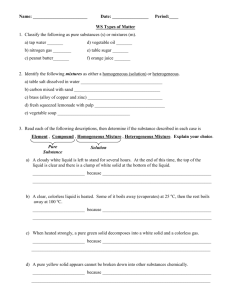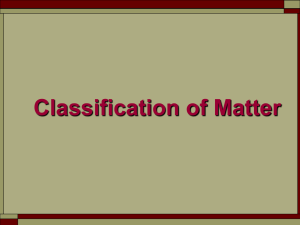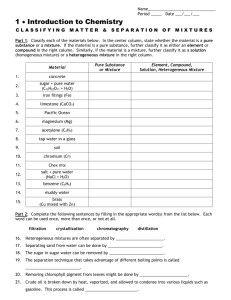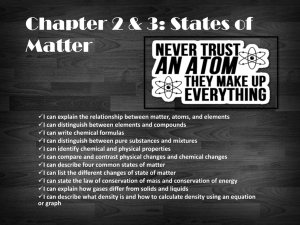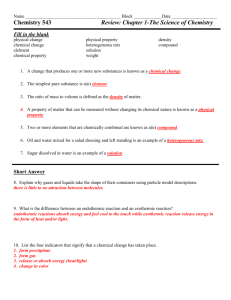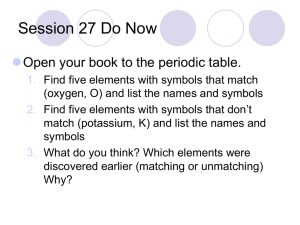Chapter 3 Matter and Energy
advertisement
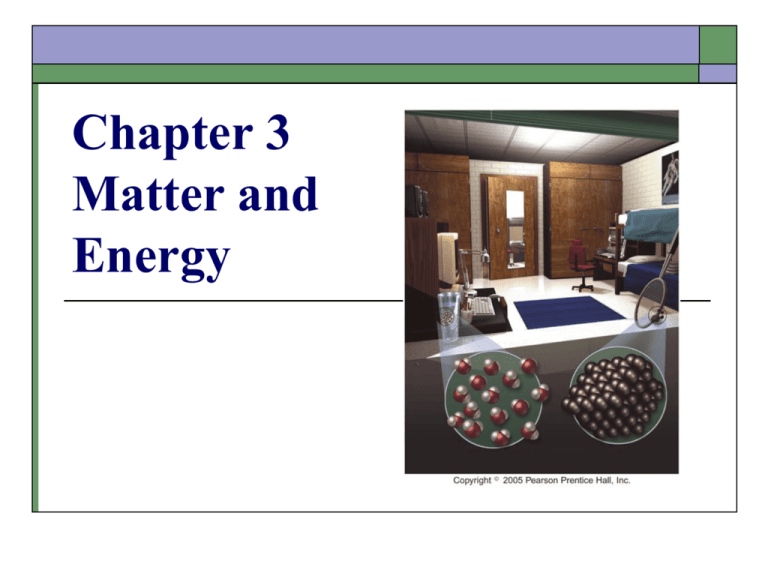
Chapter 3 Matter and Energy Matter Matter is defined as anything that occupies space and has mass–things you can see, touch, taste, or smell. States of Matter Matter can be classified as solid, liquid, or gas based on what properties it exhibits. States of Matter State Particle Spacing Shape Volume Compress Solid close fixed no Liquid close indefinite fixed no Gas indefinite indefinite yes far apart fixed Composition of Matter Matter that is composed of only one kind of atom or molecule is called a pure substance. Matter that is composed of different kinds of atoms or molecules is called a mixture. Matter Pure Substance Constant Composition Mixture Variable Composition Composition of Matter Pure substance Element—a substance that cannot be broken down into other substances by chemical methods. Compound—a substance composed of a given combination of elements that can be broken down into those elements by chemical methods. Composition of Matter Element: made of one type of atom. Compound: made of one type of molecule, or array of ions—more than one type of atom. Composition of Matter Mixture Mixtures that are uniform throughout are called homogeneous. Also known as solutions. Mixtures that have regions with different characteristics are called heterogeneous. Composition of Matter Homogeneous—appears to be one substance, all portions of a sample have the same composition and properties. Heterogeneous—presence of multiple substances can be seen, portions of a sample have different composition and properties. Composition of Matter Mixtures can be separated based on different physical properties of the components. Filtration Composition of Matter Distillation Composition of Matter Composition of Matter Classify each of the following as a pure substance (compound or element) or mixture (homogeneous or heterogeneous). 1. 2. 3. 4. 5. Pure water Gasoline Jar of jelly beans Soil Copper metal Physical and Chemical Properties The characteristics of a substance that distinguish that substance are called its properties. Physical and Chemical Properties Physical Properties are the characteristics of matter that can be changed without changing its composition. Characteristics that are directly observable. Physical and Chemical Properties Chemical Properties are the characteristics that determine how the composition of matter changes as a result of contact with other matter or the influence of energy. Characteristics that describe the behavior of matter. Physical and Chemical Changes Changes that alter the state or appearance of the matter without altering the composition are called physical changes. Physical and Chemical Changes Changes that alter the composition of the matter are called chemical changes. Physical and Chemical Properties 1. Classify each of the following as a physical or chemical property. a. Ethyl alcohol boils at 78oC b. Sugar ferments to form ethyl alcohol c. Salt is stable at room temperature, it does not decompose d. 36 g of salt will dissolve in 100 g of water 2. Classify each of the following as a physical or chemical change. a. Sugar fermenting to form ethyl alcohol b. Dissolving of sugar in water c. Iron metal melting d. Iron combining with oxygen to form rust Conservation of Mass Matter is neither created nor destroyed in a chemical reaction. Conservation of Mass 15 g elemental magnesium is burned in the presence of oxygen; 25 g white magnesium oxide result. What mass oxygen was used up? Energy Energy is anything that has the capacity to do work. All chemical and physical changes result in the matter changing energy. Energy Potential energy is energy that is stored. Kinetic energy is energy of motion, or energy that is being transferred from one object to another. Energy Energy can neither be created nor destroyed. Energy calorie (cal) is the amount of energy needed to raise one gram of water by 1 °C. Energy Conversion Factors 1 calorie (cal) = 4.184 joules (J) 1 Calorie (Cal) = 1000 calories (cal) 1 kilowatt-hour (kWh) = 3.60 x 106 joules (J) Energy and Chemical/Physical Change Exothermic process—when a chemical or physical change results in the release of energy Reactants Potential energy Surroundings Amount of energy released Products reaction Energy and Chemical/Physical Change Endothermic process—when a chemical or physical change requires the absorption of energy Products Potential energy Surroundings Amount of energy absorbed Reactants reaction Energy and Chemical/Physical Change Classify each process as exothermic or endothermic 1. 2. 3. 4. 5. Your hand gets cold when you touch ice. The ice gets warmer when you touch it. Water boils in a kettle being heated on a stove. Water vapor condenses on a cold pipe. Ice cream melts. Temperature A measure of the random motions of the components of a substance. Fahrenheit, Celsius, Kelvin Heat: a flow of energy between two objects due to a temperature difference between the objects. Temperature Temperature Converting between scales TK T C + 273 TC 1. 2. T F 32 1.80 T C TK 273 T F 1.80 T C + 32 The normal body temperature for a dog is approximately 102oF. What is this equivalent to on the Kelvin temperature scale? If the outside temperature is 298 K, what would you wear? What is this equivalent to on the Fahrenheit temperature scale? Heat Capacity Energy (Heat) Required to Change the Temperature of a Substance Depends On: The amount of substance being heated (grams) The temperature change (degrees). The identity of the substance. Heat Capacity Heat capacity is the amount of heat a substance must absorb to raise its temperature by 1 °C. Specific heat = heat capacity of 1 gram of the substance. Heat Capacity Specific Heat Capacities Substance Specific Heat J/g°C Aluminum 0.903 Carbon (dia) 0.508 Carbon (gra) 0.708 Copper 0.385 Gold 0.128 Iron 0.449 Lead 0.128 Silver 0.235 Ethanol 2.42 Water (l) 4.184 Water (s) 2.03 Water (g) 2.02 Summary of Topics: Chapter 3 Matter Pure substances: compounds and elements Mixtures: homogeneous and heterogeneous Chemical, Physical properties Chemical, Physical changes Energy, exothermic and endothermic Temperature conversions Heat Capacity (qualitative)


